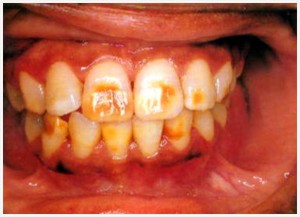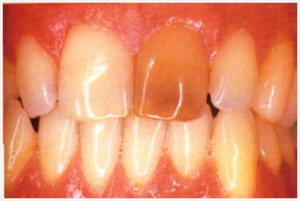Whitening of a tooth through the application of chemical agents to oxidize / reduce the organic pigmentation in the tooth.
 BLEACHING OF DISCOLORED TEETH:
Causes:
- Decomposition of pulp tissue.
- Excessive hemorrhage following pulp removal.
- Trauma.
- Medicaments.
- Filling Materials.
May be due to systemic conditions like
- Red or Purple – Congenital porphyria
- Violaceous – hereditary opalescent dentin
- Mottled brown – Endemic fluorosis
- Grayish brown – Erythroblastosis foetalis
- Brown – Jaundice.
- Yellow – brown Gray – Tetracycline
- group of Antibiotics
Classifications:
- Extrinsic Discoloration
Found on the outer surface of the teeth and are usually of local origin.- Tobacco Stains
- Tea Stains
- Nasmyths membrane in children
- Silver nitrate
Rx
Oral prophylaxis - Intrinsic Discoloration
Stains within the enamel and dentin caused by deposition or incorporation of substances within these structures.
Eg: Tetracycline stains Fluorosis Stains
Dentinogenesis Imperfecta Systemic conditions
Pulp necrosis Iatrogenic.
Bleaching Agents:
- Superoxol
30% solution of hydrogen peroxide by weight and 100% volume in pure distilled water.
It is clear, colorless, odorless liquid stored in light-proof amber bottles.It is unstable and should be kept away from heat Care to be taken during handling as it has its chemical effect on skin and mucous membraneSuperoxol can be used alone or mixed with Na Perborate into a paste for use in walking bleach.
- Sodium Perborate:
It is a stable, white powder supplied in a granular form. It is water soluble and decomposes into Na metaborate and hydrogen peroxide releasing O2Na P + H2O2 H2O + Na. M + O2When sealed into pulp chamber it oxidizes and discolors the stain slowly continuing its activity over a longer period of time –Walking bleach
Indications:
Discolored Teeth
Contra Indications:
1. Too much sensitivity because of erosion of enamel, extremely large pulp, exposed root surface etc.
2. Teeth with white or opaque spots.
3. Extremely dark stains especially those with banding or with uneven distribution.
Eg: dark tetracycline stains.
4.Teeth that have been bonded, laminated or have extensive restorations.
5. Patient’s who are perfectionists or who do not have a good understanding of what bleaching can and cannot do for them.
Techniques for Bleaching:
The goal of bleaching procedures is to restore the normal color to a tooth by decolorizing the stain with powerful oxidizing or reducing agent.
The oxidizing agents used are superoxol [30% H2O2] and sodium perborate.
The technique differs in the method used to activate the superoxol to liberate O2
The walking bleach uses reaction of Na Perborate with superoxol
The other technique uses heat and light.
Different bleaching techniques :
For non vital tooth – In office bleach (Thermo catalytic) Walking bleach
For vital tooth –Mc Innes
Modified Mc Innes
Micro abrasion
Thermo catalytic
Photo flood lamp (bleach light)
Night guard / Matrix bleaching
White strips
‘WALKING BLEACH’ OR NON VITAL BLEACHING
Steps:
1. Prepare the tooth – polishing, remove surface debris
2. Apply petroleum jelly to gingival tissues
3. Adapt the rubber dam
4. Re-establish the access cavity
5. Remove any GP that extends into the pulp chamber to the level of alveolar bone.
6. Seal the orifice of the root canal with at least 1mm glass ionomer cement to prevent percolation of the bleaching agent into the apical area.
7. Remove the smear layer with 30% orthophosphoric acid
8. Flush Naocl and water to remove acid. also EDTA and Naocl may be used
9. Protect the patients face.
10. Mix sodium per borate and superoxol and carry the thick paste into pulp chamber and cover the facial surface of the pulp chamber with paste.
11. Place a cotton pledget over the bleaching paste.
12. Seal the cavity with IRM.
– Maximum bleaching effect is attained after 24 hrs
To be recalled with in 3 –7 days for evaluation
If the shade is not proper it has to be repeated
Generally 2 sittings have to be performed to restore the normal color.
Heat and light bleaching:
Tooth preparation is the same.
Later, a loose material of cotton is placed on labial surface and another is placed in the pulp chamber of the tooth and the cotton is saturated with superoxol.
This solution is activated by exposing it to light and heat from a powerful light
i.e Heat and light from photo flood lamp is aimed directly on the tooth from a distance of 2ft and temperature ranges from 115°-140°F.
Superoxol is added to the cotton every 5 min.
The tooth is subject to several six,5 min exposures.
On completion, a cotton pellet moistened with superoxol or superoxol + Na Perborate is sealed in the pulp chamber until the next appointment.
Walking bleach is preferred to Heat and light method as it is – Easy to perform.
– Consumes less time
– Requires no special equipment.

